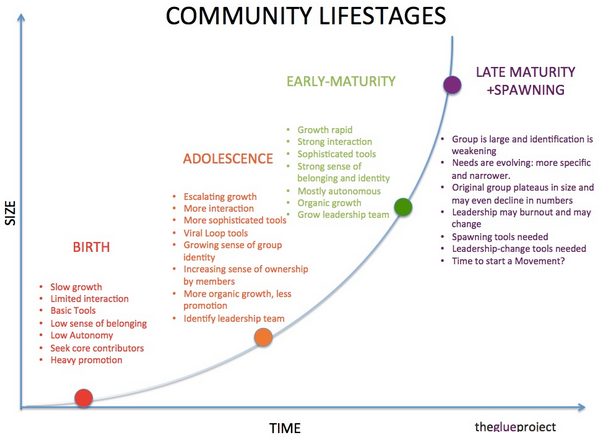This is a guest post from Douglas Atkin, CEO at The Glue Project and author of “The Culting of Brands.”

What happens between the moment of birth and spawning (when the community is mature-the subject of the last post)? Communities go through recognizable life-stages as they grow. You should be aware of them because you can anticipate and meet the community’s needs by both providing the right tools at the right time and tasking yourself with the right leadership actions appropriate to each stage. And if you’re building a community platform, it’s smart to be aware of what stage needs what tools, when… crowding a new community with tools it doesn’t need can confuse the user experience.
Above is a simplified diagram of the stages and what they need.
Below is a bit more of a description.
Birth
At this stage it’s unlikely that you have a real community on your hands… yet. You’re in the build phase and all you need are tools for basic interactions because relationships between members are only beginning. Your goals are to:
- Define the purpose, goals, and membership profile of the community (who should belong and who shouldn’t).
- Focus on recruiting doers and contributors (content writers, meeting organizers, etc.) who can quickly fill the community with desirable content and make connections.
- Make the community look attractive by showcasing that content with photos, board postings, video, and activity feed.
- Promote the community.
- Make new members feel welcome.
- Encourage interaction between members.
- Avoid the ’empty restaurant’ syndrome by encouraging activity and showcasing it on an activity feed and by showing a rising member count.
Adolescence
Now the community is taking off. Relationships are being formed between members so more sophisticated tools are needed. Organic growth is happening because existing members are recruiting others (provide those ‘viral loop’ tools that make this frictionless) and the content is growing and making the community look useful and active. So you need to promote less but manage the relationships more (policing and dispute management) and you’ll need member management metrics and tools.
There’s a growing sense of group identity as experiences are shared and group stories and myths emerge…so make sure they are being documented in video, photos, and narrative. You probably need help running the community too so time to appoint members to roles such as ‘welcomer,’ ‘event organizer,’ etc.
What characterizes this stage is:
- More sophisticated interaction tools
- Tools for members to recruit others
- Leadership team and roles
- Strong sense of belonging and group identity
- Shared memories in photos, video, and story form
- Member-management dashboard and metrics
- Member blogs
Early Maturity
Now you’re humming. Time to recruit a larger management team as the community grows rapidly. It’s also time to offer more sophisticated interaction and event tools as people will have formed friendships and want to interact via video and face-to-face at meetings and outings. Now is also the time to anticipate spawning: the tendency for groups to hive off from the main community to maintain a sense of intimacy and/or more narrowly satisfy their needs as the membership grows larger and more diverse. Poll the members to see if they want to form sub-groups or local groups.
This stage is characterized by:
- Rapid organic growth
- Strong identity
- Strong sense of belonging
- Sophisticated interactions
- Talk shows, live and recorded video interactions, and live events
- Potential for spawning into sub-groups and local groups
- Larger management team
Late Maturity and Spawning
At this point the community may have grown large enough for you to encourage spawning to maintain cohesion and strong relationships. The original community might decline in numbers a bit as sub-groups form but no-matter. You’ve still got a growing base that’s feeling bonded and having their needs met albeit in newer, smaller groups. You may be getting tired and a little burnt out. Don’t worry it’s normal. Good to recognize it and time to figure out a succession plan so you can start over with a new group or retire to the pub.
Or, if your community is mission-driven (its goal is to improve the lives of others or change the world in some way) time to consider whether you want the community to become more of an activist organization: set a big goal, raise donations, and sign petitions.
What characterizes this stage is:
- The community is large… maybe too large.
- It’s likely to spawn smaller communities that maintain a sense of intimacy and more narrowly satisfy the needs of members.
- But you will have anticipated this by identifying those needs by forming sub-groups and the potential members and leaders fill them.
- You may be getting tired… time to think of succession or a different role.
- Indeed, your original community may adopt a different role… that of an activist organization for example.
About Douglas Atkin
Douglas believes that community is the engine of loyalty -- to companies, brands, religions, causes, sports teams, whatever -- and that social glue is generally a good thing. He works with organizations to create to create stronger glue through better community platforms and programs. He does this through his venture: The Glue Project.
- Web |
- More Posts(12)


